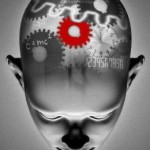PSYCHOSIS AND MANIA
 The psychotic disorders include schizophrenia, the manic phase of bipolar (manic-depressive) illness, acute idiopathic psychotic illnesses, and other conditions marked by severe agitation. All exhibit major disturbances in reasoning, often with delusions and hallucinations. Several classes of drugs are effective for symptomatic treatment. Antipsychotic agents also are useful alternatives to electroconvulsive therapy (ECT) in severe depression with psychotic features, and sometimes are used in the management of patients with psychotic disorders associated with delirium or dementia, or induced by other agents (e.g., stimulants or L-dopa).
The psychotic disorders include schizophrenia, the manic phase of bipolar (manic-depressive) illness, acute idiopathic psychotic illnesses, and other conditions marked by severe agitation. All exhibit major disturbances in reasoning, often with delusions and hallucinations. Several classes of drugs are effective for symptomatic treatment. Antipsychotic agents also are useful alternatives to electroconvulsive therapy (ECT) in severe depression with psychotic features, and sometimes are used in the management of patients with psychotic disorders associated with delirium or dementia, or induced by other agents (e.g., stimulants or L-dopa).
Effective and clinically employed antipsychotic agents include phenothiazines, structurally similar thioxanthenes, benzepines, butyrophenones (phenylbutylpiperidines), diphenylbutylpiperidines, indolones, and other heterocyclic compounds. Because these chemically dissimilar drugs share many properties, information about their pharmacology and clinical uses is grouped. Particular attention is paid to chlorpromazine, the prototype of the phenothiazine-thioxanthene group of antipsychotic agents, and to haloperidol, the original butyrophenone and representative of several related classes of aromatic butylpiperidine derivatives. Contrasts to chemically dissimilar modern agents are highlighted.
The term neuroleptic is often applied to drugs that have relatively prominent experimental and clinical evidence of antagonism of D2-dopamine receptor activity, with substantial risk of adverse extrapyramidal neurological effects and increased release of prolactin. The term atypical antipsychotic is applied to agents that are associated with substantially lower risks of such extrapyramidal effects. Representative examples include aripiprazole, clozapine, quetiapine, ziprasidone, and low doses of olanzapine and risperidone.
Although the antipsychotic drugs have had a revolutionary, beneficial impact on medical and psychiatric practice, their liabilities, especially the adverse effects of the older typical or neuroleptic agents, must be emphasized. Newer antipsychotics are atypical in having less risk of extra pyramidal side effects, but these agents present their own spectrum of adverse effects, including hypotension, seizures, weight gain, and increased risk of type II diabetes mellitus and hyper lipidemia.
The psychoses are among the most severe psychiatric disorders, in which there is not only marked impairment of behaviour, but also a serious inability to think coherently, to comprehend reality, or to gain insight into the presence of these abnormalities. These common disorders (affecting perhaps 1% of the population at some age) typically include symptoms of false beliefs (delusions) and abnormal sensations (hallucinations). Their etiological basis remains unknown, although genetic, neurodevelopmental, and environmental causative factors have all been proposed. Representative syndromes in this category include schizophrenia, brief psychoses, and delusional disorders. Psychotic features also occur in major mood disorders, particularly mania and severe melancholic depression. Psychotic illnesses are characterized by disordered thought processes (as inferred from illogical or highly idiosyncratic communications) with disorganized or irrational behaviour and varying degrees of altered mood that can range from excited agitation to severe emotional withdrawal. Idiopathic psychoses characterized by chronically disordered thinking and emotional withdrawal, and often associated with delusions and auditory hallucinations, are called schizophrenia. Acute and recurrent idiopathic psychoses that bear an uncertain relationship to schizophrenia or the major affective disorders also occur. Delusions that are more or less isolated are characteristic of delusional disorder or paranoia.
The beneficial effects of antipsychotic drugs are not limited to schizophrenia. They also are employed in disorders ranging from postsurgical delirium and amphetamine intoxication to paranoia, mania, psychotic depression, and the agitation of Alzheimer’s dementia. They are especially useful in severe depression and possibly in other conditions marked by severe turmoil or agitation.
Several cognitive functions, including auditory processing and attention, spatial organization, verbal learning, semantic and verbal memory, and executive functions, are impaired in schizophrenia patients and are a major source of social and occupational dysfunction and disability. Potent D2-antagonist neuroleptics have very limited beneficial effects on such functions. Some atypical antipsychotic agents with mixed D2/5-HT2A activity (including clozapine, quetiapine, olanzapine, and risperidone), as well as the D2 partial agonist aripiprazole, seem to improve cognitive functioning in psychotic patients in social and occupational function during long-term treatment of chronically psychotic patients with these drugs are not well documented.
Antipsychotic drugs have inconsistent effects on sleep patterns but tend to normalize sleep disturbances characteristic of many psychoses and mania. The ability to prolong and enhance the effect of opioid and hypnotic drugs appears to parallel the sedative, rather than the neuroleptic, potency of a particular agent, so that potent, less-sedating antipsychotics do not enhance sleep.
The antipsychotic drugs affect all levels of the central nervous system. Although knowledge of the actions underlying the antipsychotic and many of the neurological effects of antipsychotic drugs remains incomplete, theories based on their ability to antagonize the actions of dopamine as a neurotransmitter in the basal ganglia and limbic portions of the forebrain are most prominent. Although supported by a large body of data, these theories reflect a degree of circularity in the consideration of antipsychotic drug candidates for development after identifying their antidopaminergic activity.
Since psychosis involves disordered thought processes, cortical effects of antipsychotic drugs are of particular interest. Antipsychotic drugs interact with dopaminergic projections to the prefrontal and deep-temporal (limbic) regions of the cerebral cortex, with relative sparing of these areas from adaptive changes in dopamine metabolism that would suggest tolerance to the actions of neuroleptics.
Many neuroleptic drugs can lower the seizure threshold and induce discharge patterns in the electroencephalogram (EEG) ¾effects associated with epileptic seizure disorders. Clozapine, olanzapine, and aliphatic phenothiazines with low potency (such as chlorpromazine) seem particularly able to do this, while the more potent piperazine phenothiazines and thioxanthenes (notably fluphenazine and thiothixene), risperidone, and quetiapine are much less likely to have this effect. The butyrophenones and molindone variably and unpredictably rarely cause seizures. Clozapine has a clearly dose-related risk of inducing EEG abnormalities and seizures in no epileptic patients.
Antipsychotic agents, especially clozapine, olanzapine, and low-potency phenothiazines and thioxanthenes, should be used with extreme caution, if at all, in untreated epileptic patients and in patients undergoing withdrawal from CNS depressants such as alcohol, barbiturates, or benzodiazepines. Most antipsychotic drugs, especially the piperazines as well as the newer atypical agents’ aripiprazole, quetiapine, risperidone, and ziprasidone, can be used safely in epileptic patients if moderate doses are attained gradually and if concomitant anticonvulsant drug therapy is maintained. .
Because the extrapyramidal effects of many antipsychotic drugs are prominent, a great deal of interest has centred on their actions in the basal ganglia, notably the caudate nucleus, putamen, globus pallidus, and allied nuclei, which play a crucial role in the control of posture and the extrapyramidal aspects of movement. The critical pathogenic role of dopamine deficiency in this region in Parkinson’s disease, the potent activity of neuroleptics as dopamine receptor antagonists, and the striking resemblance between clinical manifestations of Parkinson’s disease and some of the neurological effects of neuroleptic drugs have all focused attention on the role of deficient dopaminergic activity in some of the neuroleptic-induced extra pyramidal effects.
By: Ammarah Khan




Thanks a lot for sharing this with all people you really realize what you’re talking approximately! Bookmarked. Please also talk over with my website =). We will have a hyperlink trade contract between us
Wow, superb blog layout! How long have you been running a blog for? you make running a blog look easy. The overall look of your web site is magnificent, as well as the content material!
You realize thus considerably when it comes to this subject, produced me individually consider it from a lot of numerous angles. Its like women and men don’t seem to be interested unless it is something to do with Woman gaga! Your own stuffs outstanding. Always maintain it up!
I was recommended this web site via my cousin. I am no longer certain whether this submit is written via him as no one else recognise such distinctive approximately my problem. You’re incredible! Thanks!